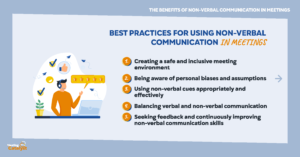Nonverbal communication plays a pivotal role in professional settings, often conveying more than words alone. It includes body language, facial expressions, gestures, posture, eye contact, and even the tone of voice. Understanding the impact of these nonverbal cues is crucial for effective communication in the workplace. Let’s explore how nonverbal communication influences interactions in professional environments and why it’s essential to be aware of the messages you send without speaking.

Understanding Nonverbal Cues
Nonverbal communication can complement, reinforce, or even contradict what is being said verbally. For example, a firm handshake can reinforce confidence during a business introduction, while avoiding eye contact may suggest disinterest or discomfort. These cues are often interpreted subconsciously by others, shaping their perceptions of you and your message.
In a professional setting, being mindful of your nonverbal communication can help you establish credibility, build rapport, and navigate complex interpersonal dynamics. By aligning your body language with your verbal message, you can ensure that your communication is clear and effective.
The Role of Body Language
Body language is one of the most visible forms of nonverbal communication. It includes gestures, posture, and movements that can convey confidence, openness, or nervousness. For instance, standing tall with shoulders back and maintaining an open posture signals confidence and authority. On the other hand, slouching or crossing your arms can make you appear defensive or unsure.
In meetings or presentations, confident body language can enhance your message and engage your audience. It’s important to be aware of your posture, gestures, and movements to ensure they support your communication goals.
The Importance of Eye Contact
Eye contact is a powerful nonverbal cue that can convey interest, attentiveness, and confidence. In professional settings, maintaining appropriate eye contact is essential for building trust and demonstrating engagement. It shows that you are focused on the conversation and value the other person’s input.
However, the level of eye contact should be balanced. Too little can make you seem disengaged or evasive, while too much can be perceived as aggressive or confrontational. Aim for a steady, natural gaze to create a positive connection with your colleagues or clients.
Facial Expressions and Their Impact
Facial expressions are another key aspect of nonverbal communication that can greatly influence professional interactions. A smile can create a warm and welcoming atmosphere, while a frown may indicate displeasure or confusion. Your facial expressions should align with your verbal message to avoid sending mixed signals.
In customer-facing roles, maintaining a friendly and approachable expression is vital for creating positive experiences. Similarly, in team settings, a supportive and understanding expression can foster collaboration and trust among colleagues.
Tone of Voice
The tone of your voice can significantly affect how your message is received. It includes elements like pitch, volume, and pace, which can convey emotions such as enthusiasm, frustration, or indifference. In professional settings, a calm and controlled tone is often most effective, as it projects confidence and professionalism.
When delivering important information, varying your tone can help emphasize key points and keep your audience engaged. Conversely, a monotonous or overly harsh tone can detract from your message and alienate your listeners.
Nonverbal Communication in Virtual Settings
With the rise of remote work and virtual meetings, nonverbal communication has taken on new forms. In video conferences, for example, your facial expressions, eye contact, and gestures are still visible and impactful. It’s important to be mindful of your nonverbal cues even in virtual settings to maintain professionalism and connection.
Positioning your camera at eye level, maintaining a professional appearance, and using deliberate gestures can help convey your message effectively during virtual interactions. Additionally, being aware of background distractions and ensuring a focused environment can enhance the clarity of your nonverbal communication.
Conclusion
Nonverbal communication is a critical component of professional interactions, influencing how your message is received and perceived. By understanding and controlling your body language, eye contact, facial expressions, and tone of voice, you can enhance your communication effectiveness and build stronger professional relationships. In today’s diverse work environments, being aware of the impact of nonverbal cues is essential for success.




